Legal Opinion: Property Rights, Co-Ownership & Landlord Tenant Law
VerifiedAdded on 2023/06/12
|7
|2070
|291
Report
AI Summary
This report provides a legal opinion on various co-ownership issues related to property rights and landlord-tenant law. It addresses scenarios involving joint and several mortgage clauses, Torrens Title, and the rights of tenants in common. The analysis covers the entitlement of a defaulter to rent collected by a partner, the rights of tenants under joint and several mortgages, and the sharing of profits from personal businesses conducted on jointly owned property. Relevant laws such as the Torrens Title clause, Joint and Several clause, and the Trust and Land Appointment of Trustees Act are applied to the facts presented in each question, providing a clear conclusion on the expected legal outcomes. Desklib offers a wealth of similar solved assignments and study resources for students.
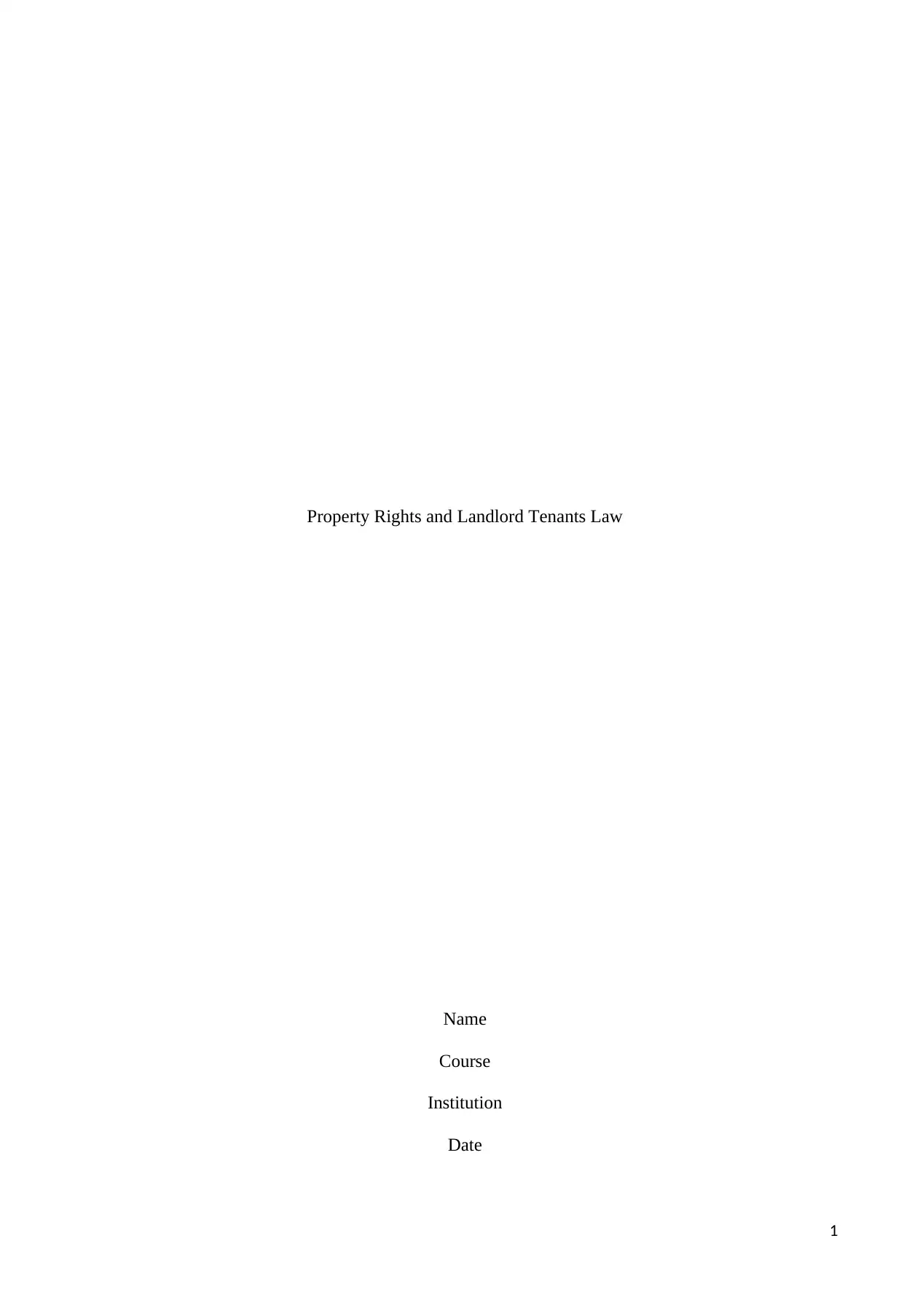
Property Rights and Landlord Tenants Law
Name
Course
Institution
Date
1
Name
Course
Institution
Date
1
Paraphrase This Document
Need a fresh take? Get an instant paraphrase of this document with our AI Paraphraser
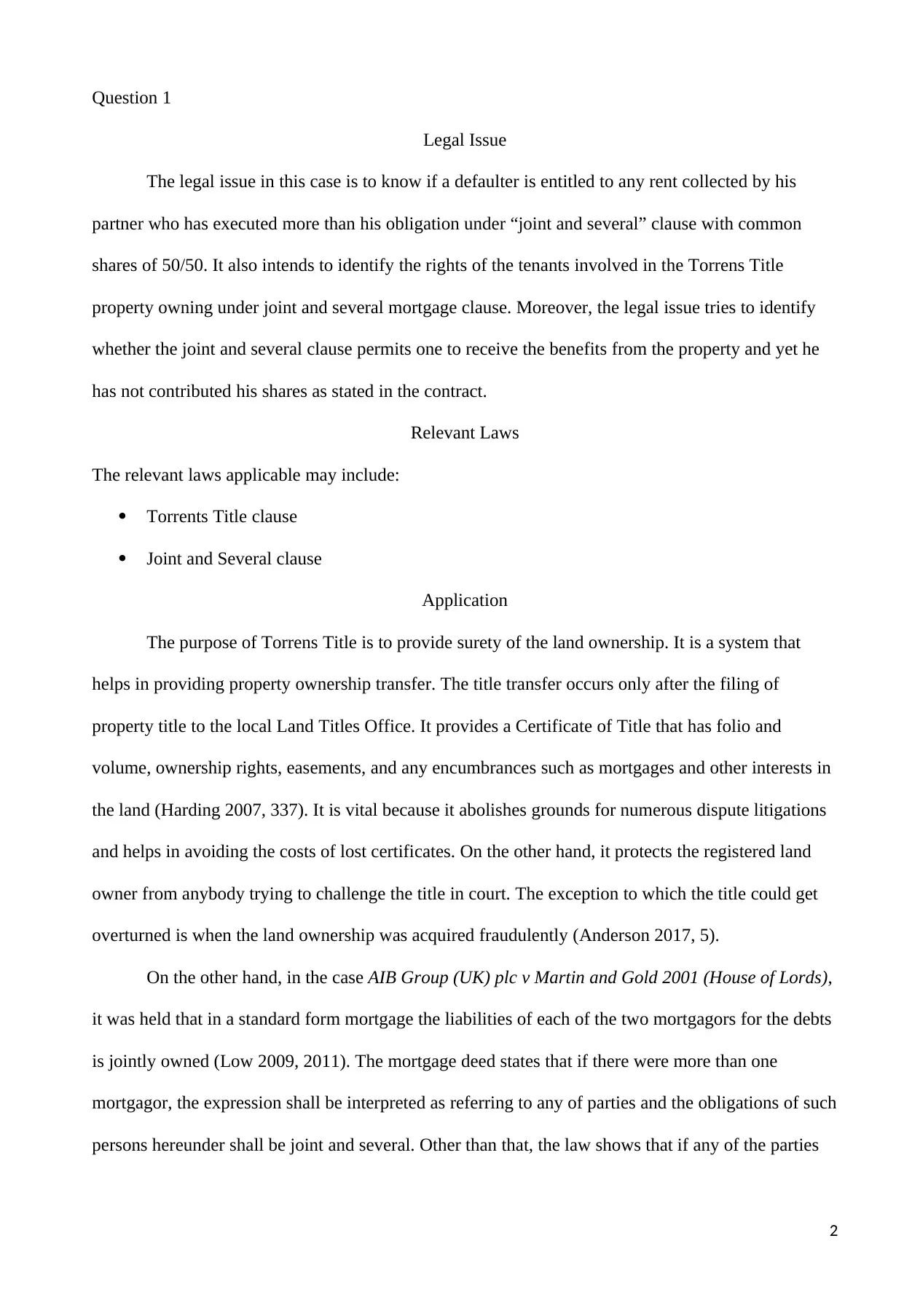
Question 1
Legal Issue
The legal issue in this case is to know if a defaulter is entitled to any rent collected by his
partner who has executed more than his obligation under “joint and several” clause with common
shares of 50/50. It also intends to identify the rights of the tenants involved in the Torrens Title
property owning under joint and several mortgage clause. Moreover, the legal issue tries to identify
whether the joint and several clause permits one to receive the benefits from the property and yet he
has not contributed his shares as stated in the contract.
Relevant Laws
The relevant laws applicable may include:
Torrents Title clause
Joint and Several clause
Application
The purpose of Torrens Title is to provide surety of the land ownership. It is a system that
helps in providing property ownership transfer. The title transfer occurs only after the filing of
property title to the local Land Titles Office. It provides a Certificate of Title that has folio and
volume, ownership rights, easements, and any encumbrances such as mortgages and other interests in
the land (Harding 2007, 337). It is vital because it abolishes grounds for numerous dispute litigations
and helps in avoiding the costs of lost certificates. On the other hand, it protects the registered land
owner from anybody trying to challenge the title in court. The exception to which the title could get
overturned is when the land ownership was acquired fraudulently (Anderson 2017, 5).
On the other hand, in the case AIB Group (UK) plc v Martin and Gold 2001 (House of Lords),
it was held that in a standard form mortgage the liabilities of each of the two mortgagors for the debts
is jointly owned (Low 2009, 2011). The mortgage deed states that if there were more than one
mortgagor, the expression shall be interpreted as referring to any of parties and the obligations of such
persons hereunder shall be joint and several. Other than that, the law shows that if any of the parties
2
Legal Issue
The legal issue in this case is to know if a defaulter is entitled to any rent collected by his
partner who has executed more than his obligation under “joint and several” clause with common
shares of 50/50. It also intends to identify the rights of the tenants involved in the Torrens Title
property owning under joint and several mortgage clause. Moreover, the legal issue tries to identify
whether the joint and several clause permits one to receive the benefits from the property and yet he
has not contributed his shares as stated in the contract.
Relevant Laws
The relevant laws applicable may include:
Torrents Title clause
Joint and Several clause
Application
The purpose of Torrens Title is to provide surety of the land ownership. It is a system that
helps in providing property ownership transfer. The title transfer occurs only after the filing of
property title to the local Land Titles Office. It provides a Certificate of Title that has folio and
volume, ownership rights, easements, and any encumbrances such as mortgages and other interests in
the land (Harding 2007, 337). It is vital because it abolishes grounds for numerous dispute litigations
and helps in avoiding the costs of lost certificates. On the other hand, it protects the registered land
owner from anybody trying to challenge the title in court. The exception to which the title could get
overturned is when the land ownership was acquired fraudulently (Anderson 2017, 5).
On the other hand, in the case AIB Group (UK) plc v Martin and Gold 2001 (House of Lords),
it was held that in a standard form mortgage the liabilities of each of the two mortgagors for the debts
is jointly owned (Low 2009, 2011). The mortgage deed states that if there were more than one
mortgagor, the expression shall be interpreted as referring to any of parties and the obligations of such
persons hereunder shall be joint and several. Other than that, the law shows that if any of the parties
2
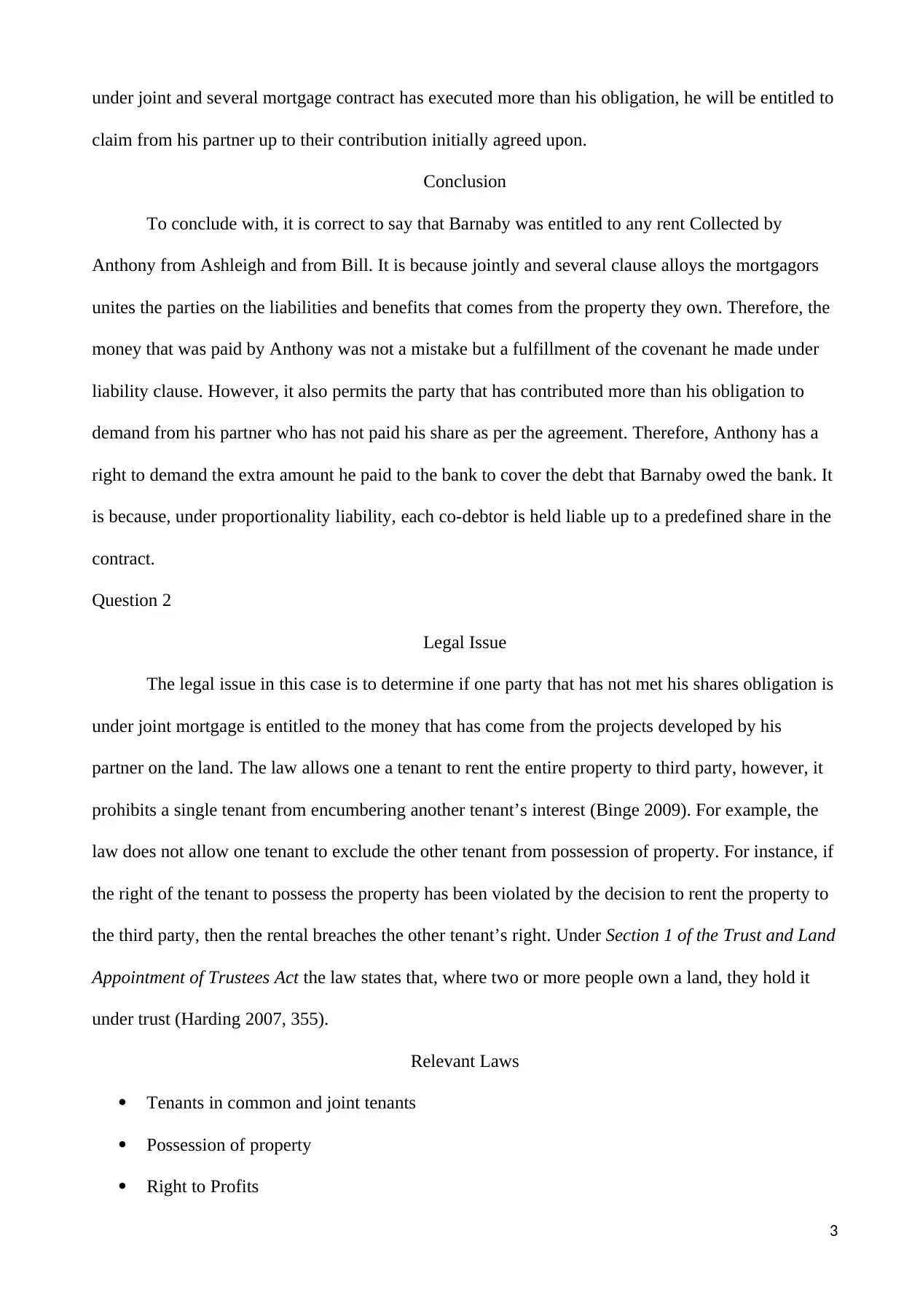
under joint and several mortgage contract has executed more than his obligation, he will be entitled to
claim from his partner up to their contribution initially agreed upon.
Conclusion
To conclude with, it is correct to say that Barnaby was entitled to any rent Collected by
Anthony from Ashleigh and from Bill. It is because jointly and several clause alloys the mortgagors
unites the parties on the liabilities and benefits that comes from the property they own. Therefore, the
money that was paid by Anthony was not a mistake but a fulfillment of the covenant he made under
liability clause. However, it also permits the party that has contributed more than his obligation to
demand from his partner who has not paid his share as per the agreement. Therefore, Anthony has a
right to demand the extra amount he paid to the bank to cover the debt that Barnaby owed the bank. It
is because, under proportionality liability, each co-debtor is held liable up to a predefined share in the
contract.
Question 2
Legal Issue
The legal issue in this case is to determine if one party that has not met his shares obligation is
under joint mortgage is entitled to the money that has come from the projects developed by his
partner on the land. The law allows one a tenant to rent the entire property to third party, however, it
prohibits a single tenant from encumbering another tenant’s interest (Binge 2009). For example, the
law does not allow one tenant to exclude the other tenant from possession of property. For instance, if
the right of the tenant to possess the property has been violated by the decision to rent the property to
the third party, then the rental breaches the other tenant’s right. Under Section 1 of the Trust and Land
Appointment of Trustees Act the law states that, where two or more people own a land, they hold it
under trust (Harding 2007, 355).
Relevant Laws
Tenants in common and joint tenants
Possession of property
Right to Profits
3
claim from his partner up to their contribution initially agreed upon.
Conclusion
To conclude with, it is correct to say that Barnaby was entitled to any rent Collected by
Anthony from Ashleigh and from Bill. It is because jointly and several clause alloys the mortgagors
unites the parties on the liabilities and benefits that comes from the property they own. Therefore, the
money that was paid by Anthony was not a mistake but a fulfillment of the covenant he made under
liability clause. However, it also permits the party that has contributed more than his obligation to
demand from his partner who has not paid his share as per the agreement. Therefore, Anthony has a
right to demand the extra amount he paid to the bank to cover the debt that Barnaby owed the bank. It
is because, under proportionality liability, each co-debtor is held liable up to a predefined share in the
contract.
Question 2
Legal Issue
The legal issue in this case is to determine if one party that has not met his shares obligation is
under joint mortgage is entitled to the money that has come from the projects developed by his
partner on the land. The law allows one a tenant to rent the entire property to third party, however, it
prohibits a single tenant from encumbering another tenant’s interest (Binge 2009). For example, the
law does not allow one tenant to exclude the other tenant from possession of property. For instance, if
the right of the tenant to possess the property has been violated by the decision to rent the property to
the third party, then the rental breaches the other tenant’s right. Under Section 1 of the Trust and Land
Appointment of Trustees Act the law states that, where two or more people own a land, they hold it
under trust (Harding 2007, 355).
Relevant Laws
Tenants in common and joint tenants
Possession of property
Right to Profits
3
⊘ This is a preview!⊘
Do you want full access?
Subscribe today to unlock all pages.

Trusted by 1+ million students worldwide
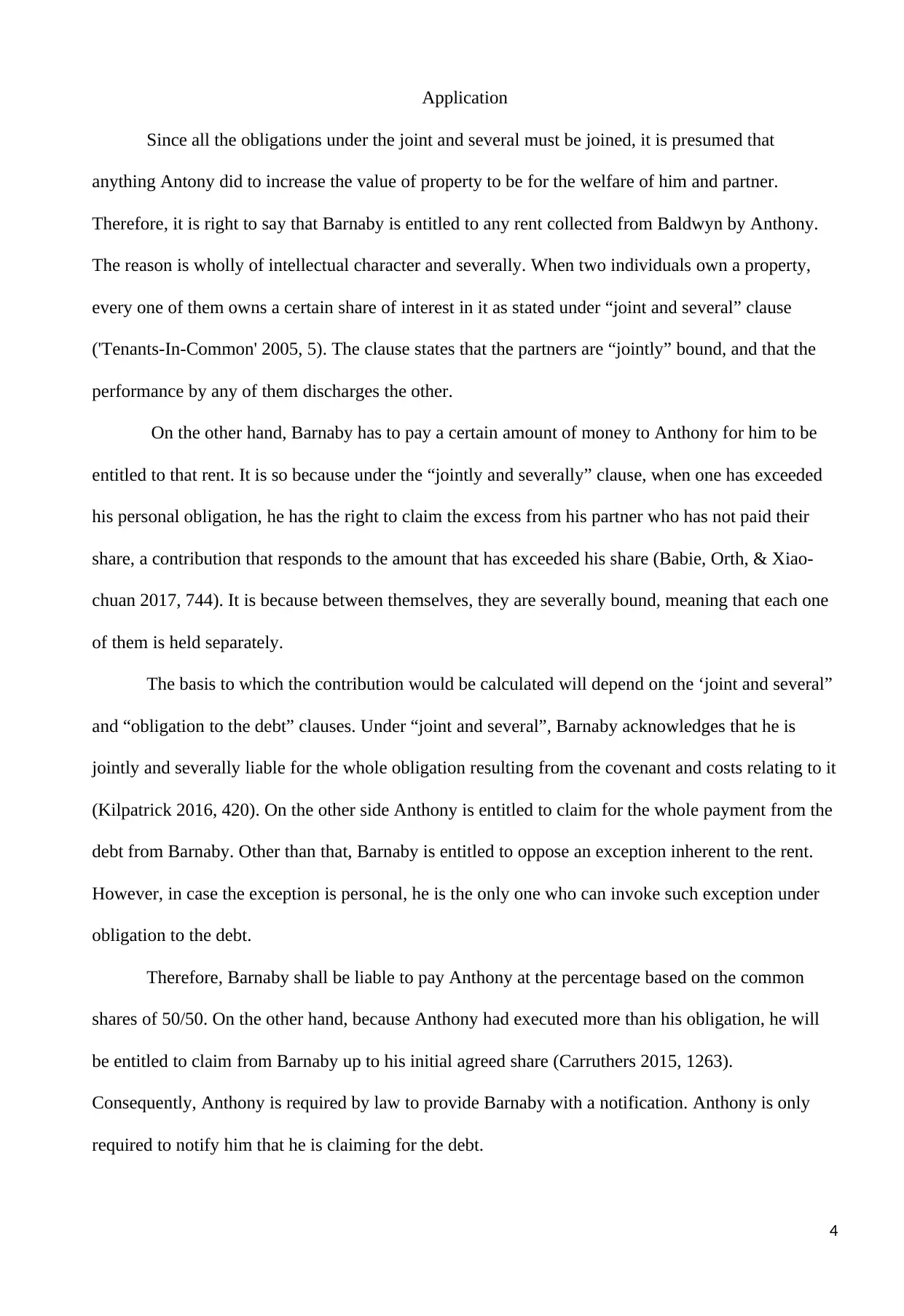
Application
Since all the obligations under the joint and several must be joined, it is presumed that
anything Antony did to increase the value of property to be for the welfare of him and partner.
Therefore, it is right to say that Barnaby is entitled to any rent collected from Baldwyn by Anthony.
The reason is wholly of intellectual character and severally. When two individuals own a property,
every one of them owns a certain share of interest in it as stated under “joint and several” clause
('Tenants-In-Common' 2005, 5). The clause states that the partners are “jointly” bound, and that the
performance by any of them discharges the other.
On the other hand, Barnaby has to pay a certain amount of money to Anthony for him to be
entitled to that rent. It is so because under the “jointly and severally” clause, when one has exceeded
his personal obligation, he has the right to claim the excess from his partner who has not paid their
share, a contribution that responds to the amount that has exceeded his share (Babie, Orth, & Xiao-
chuan 2017, 744). It is because between themselves, they are severally bound, meaning that each one
of them is held separately.
The basis to which the contribution would be calculated will depend on the ‘joint and several”
and “obligation to the debt” clauses. Under “joint and several”, Barnaby acknowledges that he is
jointly and severally liable for the whole obligation resulting from the covenant and costs relating to it
(Kilpatrick 2016, 420). On the other side Anthony is entitled to claim for the whole payment from the
debt from Barnaby. Other than that, Barnaby is entitled to oppose an exception inherent to the rent.
However, in case the exception is personal, he is the only one who can invoke such exception under
obligation to the debt.
Therefore, Barnaby shall be liable to pay Anthony at the percentage based on the common
shares of 50/50. On the other hand, because Anthony had executed more than his obligation, he will
be entitled to claim from Barnaby up to his initial agreed share (Carruthers 2015, 1263).
Consequently, Anthony is required by law to provide Barnaby with a notification. Anthony is only
required to notify him that he is claiming for the debt.
4
Since all the obligations under the joint and several must be joined, it is presumed that
anything Antony did to increase the value of property to be for the welfare of him and partner.
Therefore, it is right to say that Barnaby is entitled to any rent collected from Baldwyn by Anthony.
The reason is wholly of intellectual character and severally. When two individuals own a property,
every one of them owns a certain share of interest in it as stated under “joint and several” clause
('Tenants-In-Common' 2005, 5). The clause states that the partners are “jointly” bound, and that the
performance by any of them discharges the other.
On the other hand, Barnaby has to pay a certain amount of money to Anthony for him to be
entitled to that rent. It is so because under the “jointly and severally” clause, when one has exceeded
his personal obligation, he has the right to claim the excess from his partner who has not paid their
share, a contribution that responds to the amount that has exceeded his share (Babie, Orth, & Xiao-
chuan 2017, 744). It is because between themselves, they are severally bound, meaning that each one
of them is held separately.
The basis to which the contribution would be calculated will depend on the ‘joint and several”
and “obligation to the debt” clauses. Under “joint and several”, Barnaby acknowledges that he is
jointly and severally liable for the whole obligation resulting from the covenant and costs relating to it
(Kilpatrick 2016, 420). On the other side Anthony is entitled to claim for the whole payment from the
debt from Barnaby. Other than that, Barnaby is entitled to oppose an exception inherent to the rent.
However, in case the exception is personal, he is the only one who can invoke such exception under
obligation to the debt.
Therefore, Barnaby shall be liable to pay Anthony at the percentage based on the common
shares of 50/50. On the other hand, because Anthony had executed more than his obligation, he will
be entitled to claim from Barnaby up to his initial agreed share (Carruthers 2015, 1263).
Consequently, Anthony is required by law to provide Barnaby with a notification. Anthony is only
required to notify him that he is claiming for the debt.
4
Paraphrase This Document
Need a fresh take? Get an instant paraphrase of this document with our AI Paraphraser
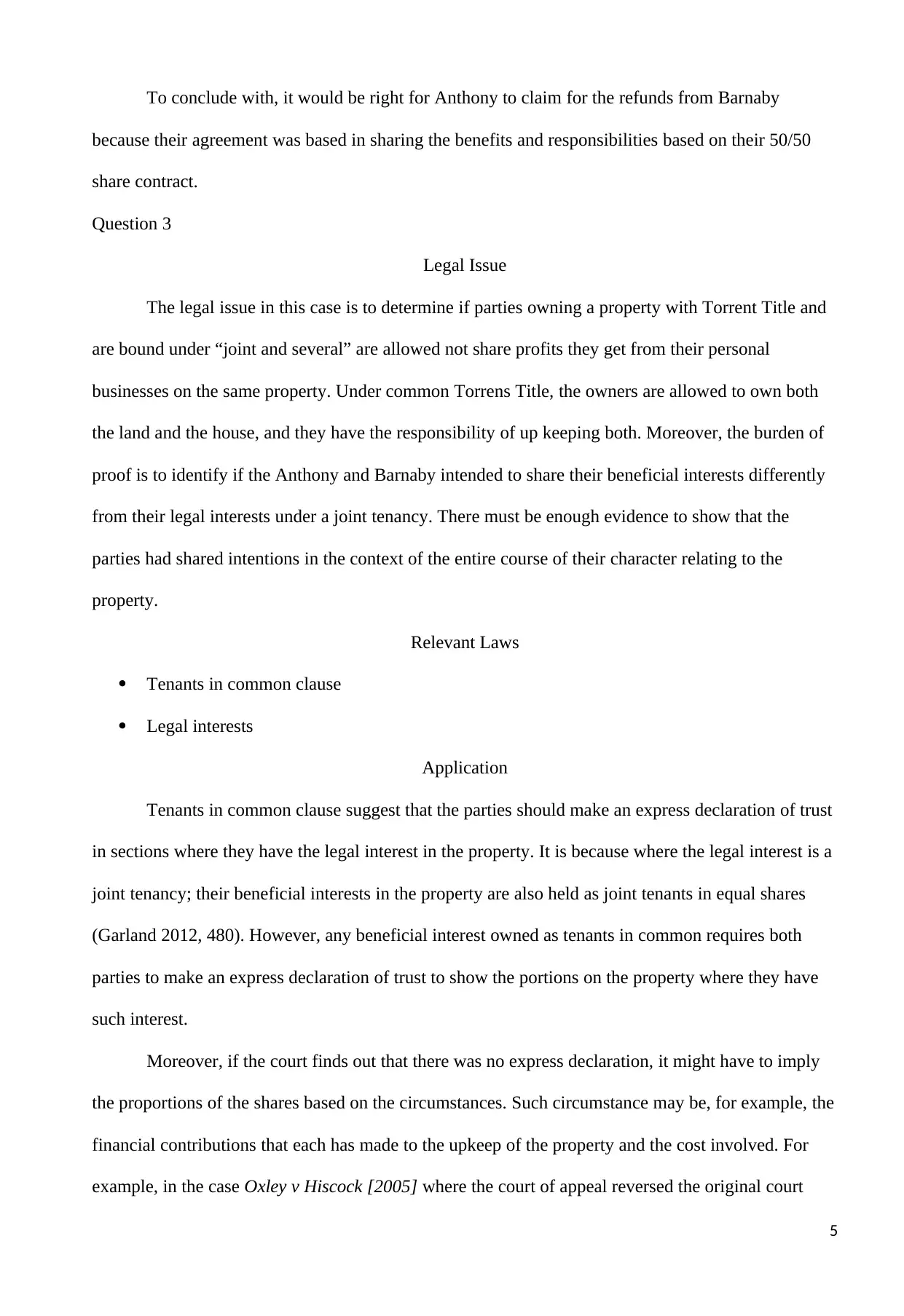
To conclude with, it would be right for Anthony to claim for the refunds from Barnaby
because their agreement was based in sharing the benefits and responsibilities based on their 50/50
share contract.
Question 3
Legal Issue
The legal issue in this case is to determine if parties owning a property with Torrent Title and
are bound under “joint and several” are allowed not share profits they get from their personal
businesses on the same property. Under common Torrens Title, the owners are allowed to own both
the land and the house, and they have the responsibility of up keeping both. Moreover, the burden of
proof is to identify if the Anthony and Barnaby intended to share their beneficial interests differently
from their legal interests under a joint tenancy. There must be enough evidence to show that the
parties had shared intentions in the context of the entire course of their character relating to the
property.
Relevant Laws
Tenants in common clause
Legal interests
Application
Tenants in common clause suggest that the parties should make an express declaration of trust
in sections where they have the legal interest in the property. It is because where the legal interest is a
joint tenancy; their beneficial interests in the property are also held as joint tenants in equal shares
(Garland 2012, 480). However, any beneficial interest owned as tenants in common requires both
parties to make an express declaration of trust to show the portions on the property where they have
such interest.
Moreover, if the court finds out that there was no express declaration, it might have to imply
the proportions of the shares based on the circumstances. Such circumstance may be, for example, the
financial contributions that each has made to the upkeep of the property and the cost involved. For
example, in the case Oxley v Hiscock [2005] where the court of appeal reversed the original court
5
because their agreement was based in sharing the benefits and responsibilities based on their 50/50
share contract.
Question 3
Legal Issue
The legal issue in this case is to determine if parties owning a property with Torrent Title and
are bound under “joint and several” are allowed not share profits they get from their personal
businesses on the same property. Under common Torrens Title, the owners are allowed to own both
the land and the house, and they have the responsibility of up keeping both. Moreover, the burden of
proof is to identify if the Anthony and Barnaby intended to share their beneficial interests differently
from their legal interests under a joint tenancy. There must be enough evidence to show that the
parties had shared intentions in the context of the entire course of their character relating to the
property.
Relevant Laws
Tenants in common clause
Legal interests
Application
Tenants in common clause suggest that the parties should make an express declaration of trust
in sections where they have the legal interest in the property. It is because where the legal interest is a
joint tenancy; their beneficial interests in the property are also held as joint tenants in equal shares
(Garland 2012, 480). However, any beneficial interest owned as tenants in common requires both
parties to make an express declaration of trust to show the portions on the property where they have
such interest.
Moreover, if the court finds out that there was no express declaration, it might have to imply
the proportions of the shares based on the circumstances. Such circumstance may be, for example, the
financial contributions that each has made to the upkeep of the property and the cost involved. For
example, in the case Oxley v Hiscock [2005] where the court of appeal reversed the original court
5
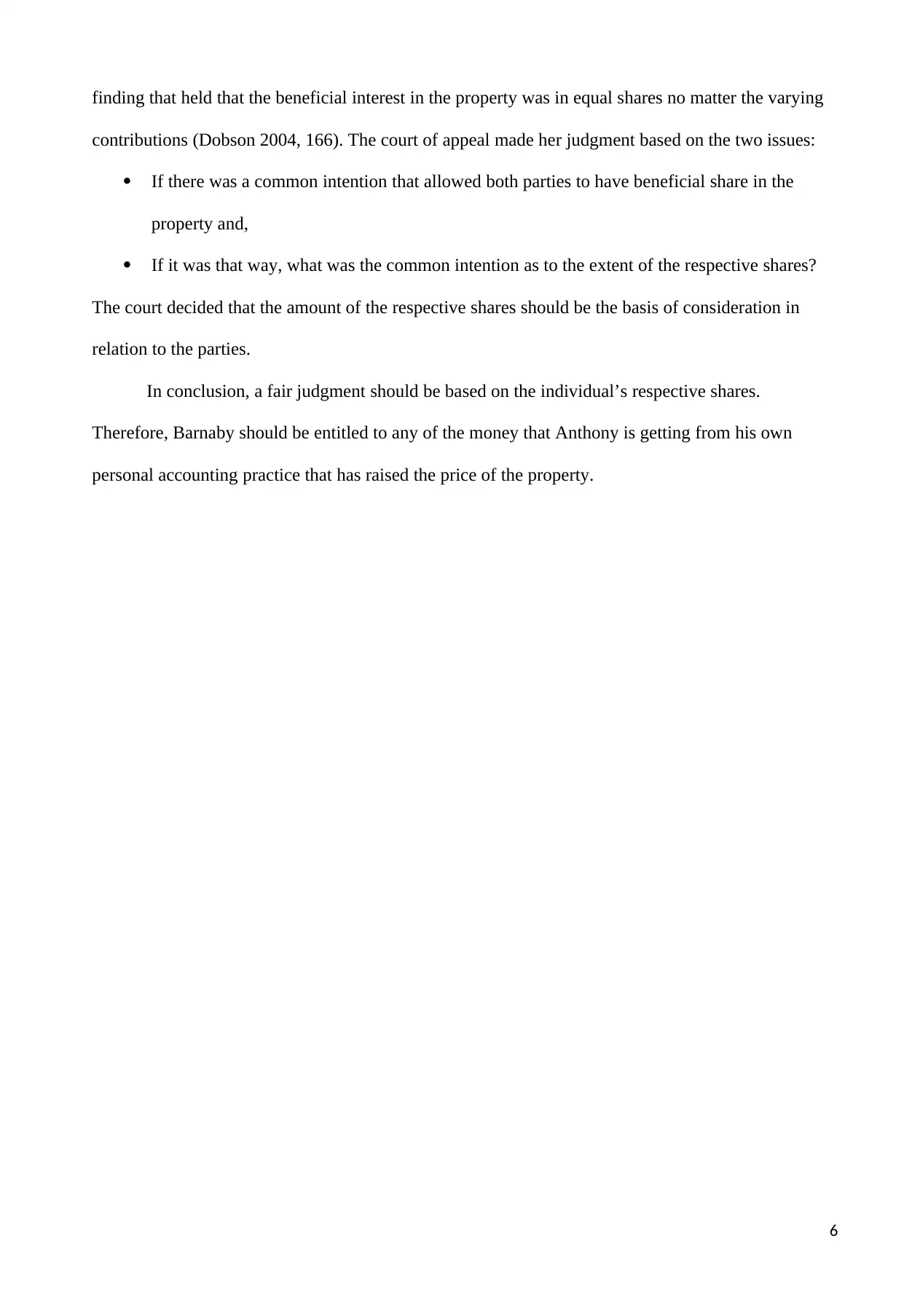
finding that held that the beneficial interest in the property was in equal shares no matter the varying
contributions (Dobson 2004, 166). The court of appeal made her judgment based on the two issues:
If there was a common intention that allowed both parties to have beneficial share in the
property and,
If it was that way, what was the common intention as to the extent of the respective shares?
The court decided that the amount of the respective shares should be the basis of consideration in
relation to the parties.
In conclusion, a fair judgment should be based on the individual’s respective shares.
Therefore, Barnaby should be entitled to any of the money that Anthony is getting from his own
personal accounting practice that has raised the price of the property.
6
contributions (Dobson 2004, 166). The court of appeal made her judgment based on the two issues:
If there was a common intention that allowed both parties to have beneficial share in the
property and,
If it was that way, what was the common intention as to the extent of the respective shares?
The court decided that the amount of the respective shares should be the basis of consideration in
relation to the parties.
In conclusion, a fair judgment should be based on the individual’s respective shares.
Therefore, Barnaby should be entitled to any of the money that Anthony is getting from his own
personal accounting practice that has raised the price of the property.
6
⊘ This is a preview!⊘
Do you want full access?
Subscribe today to unlock all pages.

Trusted by 1+ million students worldwide
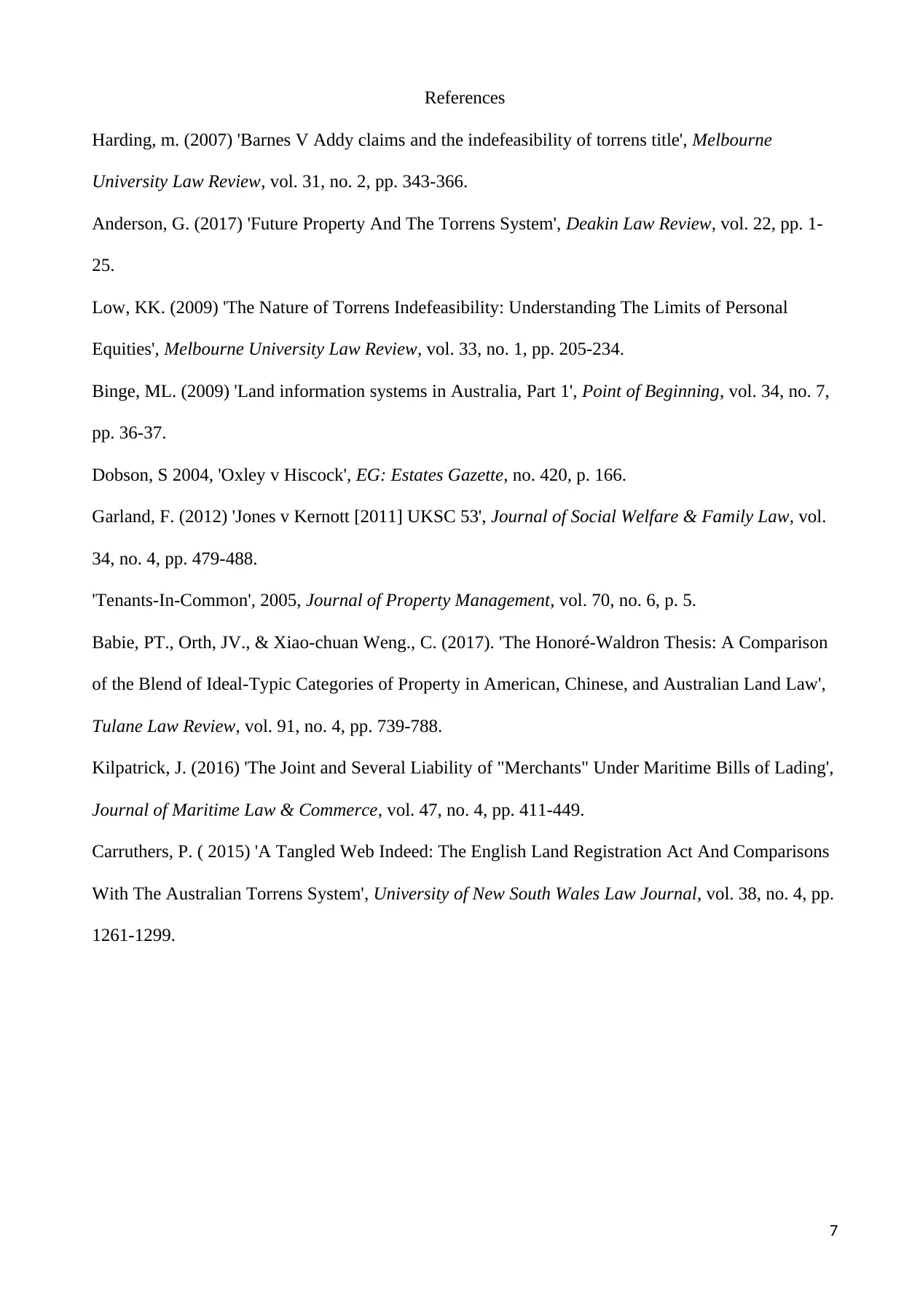
References
Harding, m. (2007) 'Barnes V Addy claims and the indefeasibility of torrens title', Melbourne
University Law Review, vol. 31, no. 2, pp. 343-366.
Anderson, G. (2017) 'Future Property And The Torrens System', Deakin Law Review, vol. 22, pp. 1-
25.
Low, KK. (2009) 'The Nature of Torrens Indefeasibility: Understanding The Limits of Personal
Equities', Melbourne University Law Review, vol. 33, no. 1, pp. 205-234.
Binge, ML. (2009) 'Land information systems in Australia, Part 1', Point of Beginning, vol. 34, no. 7,
pp. 36-37.
Dobson, S 2004, 'Oxley v Hiscock', EG: Estates Gazette, no. 420, p. 166.
Garland, F. (2012) 'Jones v Kernott [2011] UKSC 53', Journal of Social Welfare & Family Law, vol.
34, no. 4, pp. 479-488.
'Tenants-In-Common', 2005, Journal of Property Management, vol. 70, no. 6, p. 5.
Babie, PT., Orth, JV., & Xiao-chuan Weng., C. (2017). 'The Honoré-Waldron Thesis: A Comparison
of the Blend of Ideal-Typic Categories of Property in American, Chinese, and Australian Land Law',
Tulane Law Review, vol. 91, no. 4, pp. 739-788.
Kilpatrick, J. (2016) 'The Joint and Several Liability of "Merchants" Under Maritime Bills of Lading',
Journal of Maritime Law & Commerce, vol. 47, no. 4, pp. 411-449.
Carruthers, P. ( 2015) 'A Tangled Web Indeed: The English Land Registration Act And Comparisons
With The Australian Torrens System', University of New South Wales Law Journal, vol. 38, no. 4, pp.
1261-1299.
7
Harding, m. (2007) 'Barnes V Addy claims and the indefeasibility of torrens title', Melbourne
University Law Review, vol. 31, no. 2, pp. 343-366.
Anderson, G. (2017) 'Future Property And The Torrens System', Deakin Law Review, vol. 22, pp. 1-
25.
Low, KK. (2009) 'The Nature of Torrens Indefeasibility: Understanding The Limits of Personal
Equities', Melbourne University Law Review, vol. 33, no. 1, pp. 205-234.
Binge, ML. (2009) 'Land information systems in Australia, Part 1', Point of Beginning, vol. 34, no. 7,
pp. 36-37.
Dobson, S 2004, 'Oxley v Hiscock', EG: Estates Gazette, no. 420, p. 166.
Garland, F. (2012) 'Jones v Kernott [2011] UKSC 53', Journal of Social Welfare & Family Law, vol.
34, no. 4, pp. 479-488.
'Tenants-In-Common', 2005, Journal of Property Management, vol. 70, no. 6, p. 5.
Babie, PT., Orth, JV., & Xiao-chuan Weng., C. (2017). 'The Honoré-Waldron Thesis: A Comparison
of the Blend of Ideal-Typic Categories of Property in American, Chinese, and Australian Land Law',
Tulane Law Review, vol. 91, no. 4, pp. 739-788.
Kilpatrick, J. (2016) 'The Joint and Several Liability of "Merchants" Under Maritime Bills of Lading',
Journal of Maritime Law & Commerce, vol. 47, no. 4, pp. 411-449.
Carruthers, P. ( 2015) 'A Tangled Web Indeed: The English Land Registration Act And Comparisons
With The Australian Torrens System', University of New South Wales Law Journal, vol. 38, no. 4, pp.
1261-1299.
7
1 out of 7
Related Documents
Your All-in-One AI-Powered Toolkit for Academic Success.
+13062052269
info@desklib.com
Available 24*7 on WhatsApp / Email
![[object Object]](/_next/static/media/star-bottom.7253800d.svg)
Unlock your academic potential
Copyright © 2020–2025 A2Z Services. All Rights Reserved. Developed and managed by ZUCOL.





